Save Florida's Bromeliads
Some of Florida's bromeliads are on Florida's Endangered Species List and it is illegal to handle them
without permission. For more information, visit FDACS Endangered Plants Page.
Florida's BromeliadsFlorida has 16 species of bromeliads and 13 are attacked by the weevil (Frank and Cave 2005). They are: Catopsis berteroniana (Schult. & Schult. f.) Mez (Powdery strap airplant) Catopsis floribunda L. B. Sm. (Florida strap airplant) Catopsis nutans (Sw.) Griseb (Nodding strap airplant) Guzmania monostachia (L.) Rusby ex Mez (West Indian tufted airplant) Tillandsia balbisiana Schult. f. (Northern needleleaf airplant) Tillandsia fasciculata Sw. (Cardinal airplant) Tillandsia flexuosa Sw. (Twisted airplant) Tillandsia paucifolia Baker (Potbelly airplant) Tillandsia pruinosa Sw. (Fuzzy wuzzy airplant) Tillandsia setacea Sw. (Southern needleleaf airplant) Tillandsia simulata Small (Broad needleleaf airplant) Tillandsia utriculata L. (Giant airplant) Tillandsia variabilis Schltdl. (Giant airplant) The 3 bromeliad species that are not attacked by the weevil (Tillandsia usneoides L. (Spanish moss), Tillandsia recurvata L. (Ball moss), and Tillandsia bartramii Elliot (Bartram's airplant)) are too small to support weevil larval growth. All of Florida's airplants are epiphytic: They grow on trees without harming the host tree; they do not take nutrients directly from the tree; they get their nutrients from rain that falls through the canopy picking up specks of matter and from wind-blown matter and take the nutrients in through specialized cells (trichomes) on their leaves; and use their roots only as a hold-fast. Catopsis berteroniana (Shult. & Schult. f.) MezCommon names: Powdery strap airplant. Distribution: Florida, Mexico, West Indies, Central and South America. Distribution in Florida: Rare plant species found in the southern tip of Florida, in the following counties: Collier, Miami-Dade, and mainland Monroe Counties. Habitat: Rockland hammock, slough, marine tidal swamp; usually found in strong light, on high branches of host tree. Description: Tank epiphyte. Leaves are yellowish-green, up to 45 cm (18 in.), with a white, chalky, powdery covering, especially at the base. Passive plant carnivore; insects flying recognize the chalky covering as sky, bump into the plant, and fall into the tank, where they are trapped, drowned, then decomposed by resident bacteria, thus releasing nutrients for the plant. White flowers (1.0 - 1.2 cm; 3/8 - 1/2 in.), stout inflorescence. Seeds commonly germinate on the capsule. Time of flowering: All year, especially fall – winter. Mexican bromeliad weevil: Attacked by the weevil. Status in Florida: Endangered. Catopsis floribunda L.B. SmithCommon name: Florida strap airplant. Distribution: Florida, Mexico, West Indies, Central and South America. Distribution in Florida: Rare plant species found in the southern tip of Florida, in the following counties: Broward, Collier, MiamiDade, and Monroe Counties. Habitat: Humid, shady habitats: terrestrial (rockland hammock), palustrine (strand swamp). Description: Tank epiphyte. grows to 70 cm (28 in.) tall; long, bright green leaves, 20-40 cm (8-16 in.), with wide bases and narrowing at tip; flower stalk 25 cm (10 in.) or longer, with 5-15 lateral branches and 15-50 flowers; yellow or white petals; mature seed capsules up to 1.4 cm (1/2 in.) long; vegetative in every month. Time of flowering: Fall - winter. Mexican bromeliad weevil: Attacked by the weevil. Status in Florida: Endangered. Catopsis nutans (Sw.) Griseb.Common name: Nodding airplant. Distribution: Florida, Mexico, West Indies, Central and South America. Distribution in Florida: Very rare plant species found only within a few square miles in the Fakahatchee Strand in the Collier County. Habitat: Palustrine (slough) and shady, humid hammocks (deep cypress swamp). Description: Tank epiphyte; plant grows to 30 cm (12 in.); small rosettes with flexible, spreading, bright-green, tapered leaves, overlapping at bases [8-15 cm (3-6 in.) long, 2 cm (3/4 in.) at base, narrowing to tip]; leaves are chalky, especially at base; flower stalk usually simple; 3-10 orange-yellow flowers, 2 cm (3/4 in.) long, opening at night; mature capsules 1.2-2.0 cm (1/2 - 3/4 in.) long, oval. Time of flowering: Fall – spring (especially August – October). Mexican bromeliad weevil: Attacked by the weevil. Status in Florida: Endangered. Guzmania monostachia (L.) Rusby ex. MezCommon names: Guzie airplant, strap-leaved airplant. 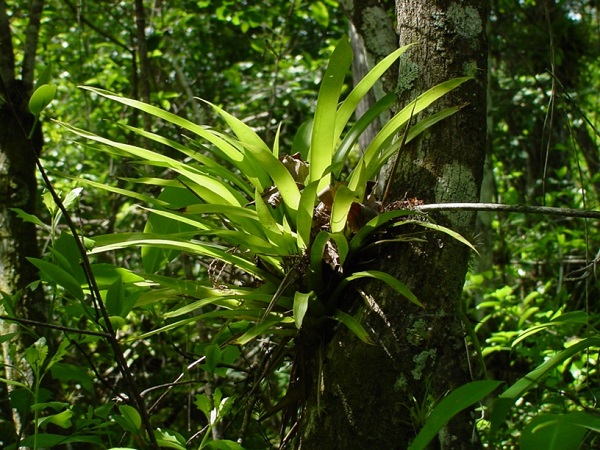
Distribution: Florida, West Indies, Mexico, Central America to northern Peru and Brazil. Distribution in Florida: Collier, Miami-Dade, mainland Monroe Counties. Habitat: Terrestrial (rockland hammock), palustrine (slough, strand swamp); most abundant on pop ash (Fraxinus caroliniana) and pond apple (Annona glabra); grows over deep sloughs. Description: Tank epiphyte; may be terrestrial; bright green, flexible, non-scaly, strap-shaped leaves, nearly parallel-sided and tapering abruptly at the tip, 2-3 cm (3/4 - 1 1/8 in.) wide and up to 50 cm (20 in.) long (usually 25-30 cm [10-12 in.]); leaves may be green-and-white striped (var. variegata); single floral spike (“monostachia” means “one spike”) up to 40 cm (16 in.), with many spirally-arranged flowers; salmon-colored apical floral bracts in Florida; white flowers, 3 cm (1 1/8in.) long; long, cylindrical seed capsules, up to 4 cm (1 1/2 in.); may produce many vegetative offshoots. Time of flowering: All year, mainly February - August, especially May – July. Mexican bromeliad weevil: Before the Mexican bromeliad weevil, large, dense, localized populations could be found in deep slough habitat, where water depth, water-holding capacity of the peat soils, and canopy provide optimal conditions. Now, these populations are being destroyed by the weevil. Status in Florida: Endangered. Tillandsia balbisiana Schult. f.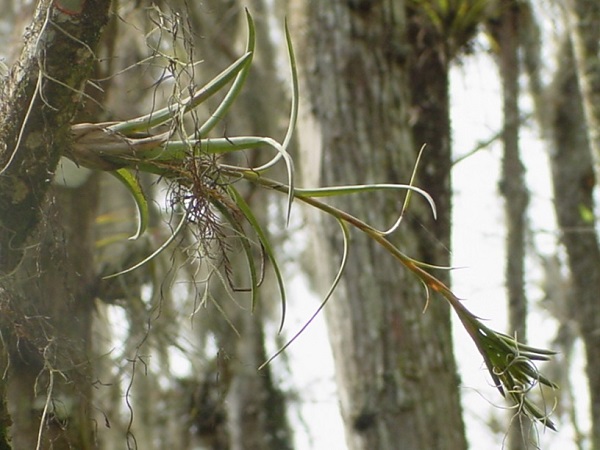
Common names: Northern needleleaf, coke bottle airplant. Distribution: Florida, Mexico, West Indies, Central and South America. Distribution in Florida: Orange, Osceola, Polk, Hillsborough, Manatee, Sarasota, DeSoto, Highlands, Okeechobee, Indian River, St. Lucie, Martin, Glades, Charlotte, Lee, Hendry, Palm Beach, Broward, Collier, Monroe, and Miami-Dade Counties. Habitat: Scrub, pinelands, strand swamp, hammocks, mangrove, sun and shade tolerant; often found growing in cypress domes. Description: Tank epiphyte; grows to 70 cm (28 in.) tall, singly or in clusters; 15-30 leaves, leathery, grayish in appearance because of scales, may be reddish; leaves slightly bulbous at base and tapering and curved or twisted at ends; flower spike usually with 2-10 lateral branches; scape 8-30 cm (3-12 in.); floral bracts (5-20 mm [1/4 - 3/4 in.] long) may be bright red, with violet petals (5-30 flowers per plant); seed capsules up to 4.5 cm (1 3/4 in.) long. Time of flowering: Fall to summer, especially early spring. Mexican bromeliad weevil: Attacked by the weevil but not as badly as other species. Status in Florida: Threatened. Tillandsia bartramii ElliottFormer names: Tillandsia juncea; Tillandsia myriophylla. Common name: Bartram's airplant. Distribution: Florida, Georgia, Caribbean, Mexico. Distribution in Florida: Alachua, Baker, Bradford, Citrus, Columbia, Dixie, Duval, Flagler, Franklin, Gilchrist, Gulf, Hernando, Highlands, Hillsborough, Indian River, Jefferson, Lafayette, Lake, Leon, Levy, Liberty, Manatee, Marion, Nassau, Orange, Osceola, Pasco, Polk, Putnam, Seminole, St. Johns, Sumter, Suwannee, Volusia, and Wakulla Counties. Habitat: Hammocks and pinelands. Description: Epiphytic; grows to 10-30 cm (4-12 in.) tall (20-40 cm [8-16 in.] when flowering); plants densely clustered; thin, leathery, grayish leaves (15-30 per plant); simple flower spike or with 1-5 side branches; pink to red floral bracts with flowers 2.5 cm (1 in.) long (5-20 per plant); seed capsules up to 3 cm (1 1/8 in.) long. Time of flowering: Spring – summer (especially spring). Mexican bromeliad weevil: The weevil does not attack this plant; the stem is too small to support weevil larval growth. Status in Florida: Not threatened. Tillandsia fasciculata Sw.Former name: T. hystricina. Common name: Cardinal airplant. 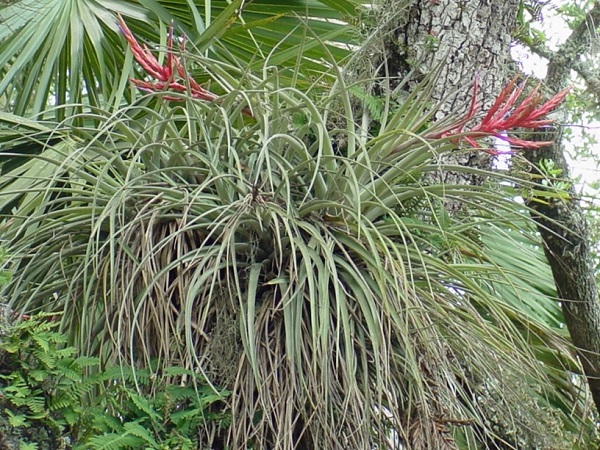
Distribution: Florida, West Indies, Mexico, Central and South America. Distribution in Florida: Brevard, Broward, Charlotte, Collier, DeSoto, Glades, Hardee, Hendry, Highlands, Hillsborough, Lee, Manatee, Martin, Miami-Dade, Monroe, Okeechobee, Orange, Osceola, Palm Beach, Pinellas, Polk, Sarasota, Seminole, and Volusia Counties. Habitat: Hammocks, cypress swamps, pinelands; often found growing in cypress domes. Description: Tank epiphyte; plants often grow in clusters; 20-50 leaves, long, stiff and leathery (grayish-green, scaly, brownish at base), 30-70 cm (1228 in.) long, wider at base and tapering to a pointed tip; inflorescence 30-60 cm (12-24 in.) tall, spikes 7-15 cm long, 3-15 side branches; floral bracts usually bright red but many color forms exist in Florida, including yellow, green, and rose; 10-50 flowers; petals violet or rarely white, 4.5 cm (1 3/4 in.) long; seeds in capsule 3 cm (1 1/8 in.) long; seeds windborne. Time of flowering: All year, especially spring to early summer. Mexican bromeliad weevil: Though large populations of the cardinal airplant can still be found, field monitoring has shown the over the long term, the weevil is just as devastating as this species as it is on T. utriculata and G. monostachia. Status in Florida: Endangered. Tillandsia flexuosa Sw.Former name: Tillandsia aloifolia Hook. Common name: Twisted airplant. 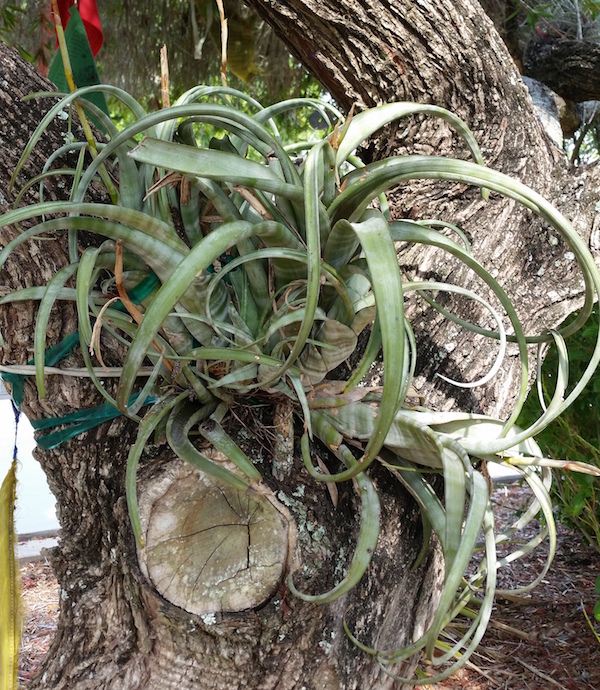
Distribution: Florida, West Indies, Panama, Venezuela, Colombia. Distribution in Florida: Rare plant species found in the southern Florida in the following counties: Broward, Charlotte, Collier, Hendry, Highlands, Lee, Martin, Miami-Dade, Monroe, Palm Beach Counties. Habitat: Exposed habitats, often near the coast; terrestrial (xeric hammock [pinelands, scrub], shell mound, rockland hammock, coastal berm, maritime hammock); marine (marine tidal swamp); estuarine (estuarine tidal swamp). Description: Exposed habitats, often near the coast; terrestrial (xeric hammock [pinelands, scrub], shell mound, rockland hammock, coastal berm, maritime hammock); marine (marine tidal swamp); estuarine (estuarine tidal swamp). Time of flowering: Every month except November and December, mostly spring to summer. Mexican bromeliad weevil: Attacked by the weevil. Status in Florida: Threatened. Tillandsia paucifolia BakerFormer names: T. circinnata, T. bulbosa. Common name: Potbelly airplant. 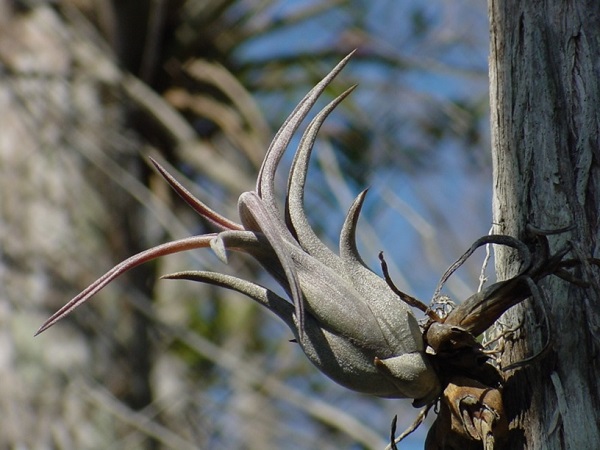
Distribution: Florida, Mexico, West Indies, Central and South America. Distribution in Florida: Rare plant species found in southern Florida in the following counties: Brevard, Broward, Charlotte, Collier, Hendry, Indian River, Lee, Manatee, Martin, MiamiDade, Monroe, Okeechobee, Osceola, Palm Beach, Sarasota, and St. Lucie Counties. Habitat: Coastal strands and hammocks, brightly exposed habitats. Often found growing on the outer edges of cypress domes in small populations. Description: Tank epiphyte; grows to 10-35 cm (4-14 in.) tall, singly or in clusters; 5-10 leaves, silvery-gray, on long pseudobulbs, twisted and narrowing into curved ends; simple flower spike (5-8 cm [2-3 in.] long), may have 2-4 lateral spikes, with 2-15 flowers; floral bracts 2-3 cm (3/4 - 1 1/8 in.), leathery, pale pink; lavender-blue petals, 2-3 cm (3/4 - 1 1/8 in.) long; mature seed capsules up to 4 cm (1 1/2 in.) long, grayish brown, pointed. Time of flowering: Spring - summer. Status in Florida: Not listed as threatened. Tillandsia pruinosa Sw.Former names: T. breviscapa. Common name: Fuzzywuzzy airplant. 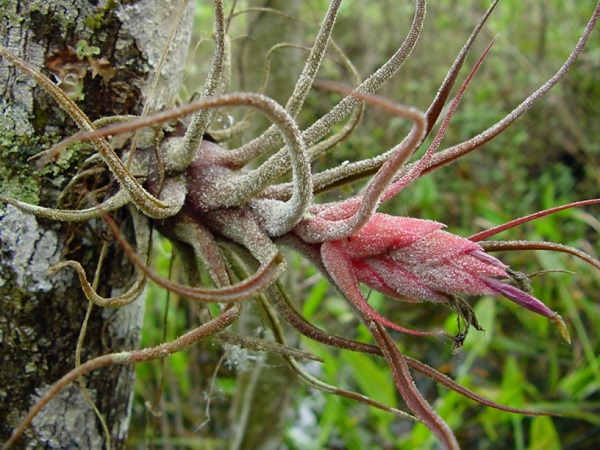
Distribution: Florida, West Indies, Central and South America. Distribution in Florida: Collier County. Occurrence in Florida: Rare. Habitat: Shady, humid hammocks; palustrine (strand swamp); on dead trees. Description: Tank epiphyte; plants usually grow singly, rarely clustered; grows to 25 cm (10 in.) tall; 5-10 leaves; scales give leaves a silvery-white, fuzzy appearance; stem is within a pseudobulb, from which leaves emerge; flower spike simple; floral bracts are pink, with 5 to many flowers; violet petals 3 cm (1 1/8 in.) long; seed capsule pointed and 3-sided, up to 4.5 cm (1 3/4 in.) long. Time of flowering: All year, especially winter to spring (mainly spring). Mexican bromeliad weevil: When the weevil first arrived, it was thought that this plant would not be attacked because it is so small. However, populations of Florida's airplants have been found that are being actively attacked by the weevil. Status in Florida: Endangered. Tillandsia recurvata L.Former names: Diaphoranthema recurvata (L.) Beer. Common name: Ball moss. Distribution: Southern U.S. (Arizona, Florida, Georgia, Louisiana, New Mexico, Texas), Mexico, Central America, West Indies, Argentina, Chile. Distribution in Florida: Commonly found in all counties. Habitat: Hammocks (usually on broad-leaved trees), pinelands and scrub; usually in brightly exposed habitats. Description: Epiphytic; grows to 12-18 cm (5-7 in.) tall, 15-18 cm (6-7 in.) in diameter; rooted crown with cluster of curving stems and compact mass of leaves resulting in ball-like growth; leaves stiff, narrow, gray-green, not dilated at base (4-8 mm [1/8 - 1/3 in.] wide); 2-5 flowers, with blue to violet petals, on long stem growing from central mass of leaves; seed capsule up to 2 cm (3/4 in.) long; several plants often grow together in masses. Time of flowering: Spring - summer. Mexican bromeliad weevil: The weevil does not attack this plant; the stem is too small to support weevil larval growth. Status in Florida: Not listed as threatened. Tillandsia setacea Sw.Former names: Tillandsia tenuifolia L. Common name: Needle-leaf airplant. Distribution: Florida, Georgia, West Indies, Central and South America. Distribution in Florida: Commonly found in the following counties: Brevard, Broward, Charlotte, Collier, DeSoto, Glades, Hardee, Hendry, Hernando, Highlands, Hillsborough, Indian River, Lake, Lee, Manatee, Martin, Miami-Dade, Monroe, Okeechobee, Orange, Osceola, Palm Beach, Pasco, Pinellas, Polk, Putnam, Sarasota, Seminole, St. Lucie, Sumter, and Volusia Counties. Habitat: Hammocks and swamps; often found growing in urban areas on fences and power lines. Description: Epiphytic; grows to 30 cm (12 in.) long; plants densely clustered, growing as aggregates of small tufts; leaves dilated at base, flexuous at tips, green to reddish-green in color; flower stalk 8-15 cm (3-6 in.); 315 flowers, 2.5 cm (1 in.) long; violet petals; seed capsule up to 3 cm (1 1/8 in.) long; similar to Tillandsia bartramii except leaves green or reddish and floral bracts green, tinged with red. Time of flowering: Spring - fall. Mexican bromeliad weevil: The weevil does not attack this plant; the stem is too small to support weevil larval growth. Status in Florida: Not listed as threatened. Tillandsia simulata SmallCommon name: Florida's airplant. 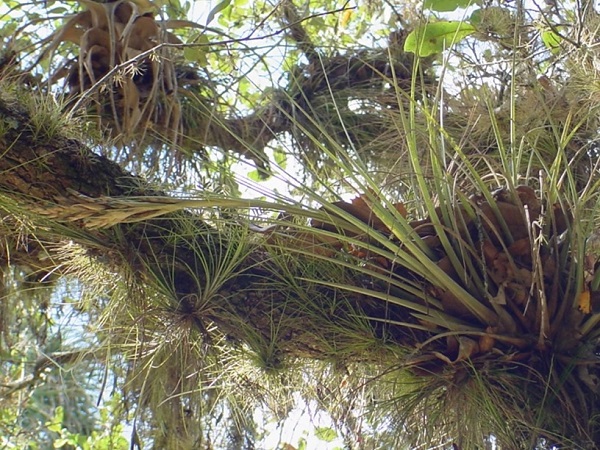
Distribution: Precinctive (found nowhere else except in Florida). Distribution in Florida: Unlike most of Florida's native bromeliads, Florida's airplant has a central distribution, including the following counties: Citrus, DeSoto, Flagler, Hernando, Highlands, Hillsborough, Indian River, Lake, Levy, Manatee, Orange, Osceola, Pasco, Pinellas, Polk, Putnam, Seminole, Sumter, and Volusia Counties. Habitat: Moist hammocks and swamps, usually in strong light. Description: Long, thin, pointed, leathery, grayish leaves; simple flower spike; purple flowers (4.5 cm [1 3/4 in.] long); seed capsules up to 3 cm (1 1/8 in.) long. Polycarpic: produces offsets (pups) as well as seed. Time of flowering: Spring - summer. Mexican bromeliad weevil: When the weevil first arrived, it was thought that this plant would not be attacked because the stems are very small. However, populations of Florida's airplants have been found that are being actively attacked by the weevil. Status in Florida: Not listed as threatened. Tillandsia usneoides (L.) L.Former names: Dendropogon usneoides (L.) Eaf. Common name: Spanish moss. Distribution: From southeast U.S. (Virginia, North Carolina, South Carolina, Georgia, Florida, Alabama, Louisiana, Mississippi, Arkansas, Texas) to central Argentina and Chile (Spanish moss has the broadest geographical range of any bromeliad). Distribution in Florida: Commonly found in all counties in Florida. Habitat: Hammocks (usually on oaks), pinelands and scrub; prefers moist, brightly exposed habitats; can withstand extreme temperature fluctuation and low rainfall; often found growing in urban areas on fences and powerlines. Description: Epiphytic; rootless; abundantly branching; plants overlap on tree branches; plants usually 15-20 cm (6-8 in.) long (up to 45 cm [18 in.] long); leaves (3-5 cm [1-2 in.] long) not dilated at the base (1-2 mm [1/16 in.] wide); live leaves covered with gray-green scales; leaves greener when plant is in good health (gray leaves may indicate moisture stress or other environmental factors); flowers (usually one per plant) greenish-yellow and fragrant, lasting about 4 days; seed capsules 15-20 mm (1/2 -3/4 in.) long; seeds (2-23 per capsule) 2-3 mm (1/8 in.) long, with comate hairs; reproduces by seed and vegetative growth. Time of flowering: Spring (mainly April). Mexican bromeliad weevil: The weevil does not attack this plant; the stem is too small to support weevil larval growth. Status in Florida: Not listed as threatened. Tillandsia utriculata L.Common names: Giant wild pine, giant airplant. 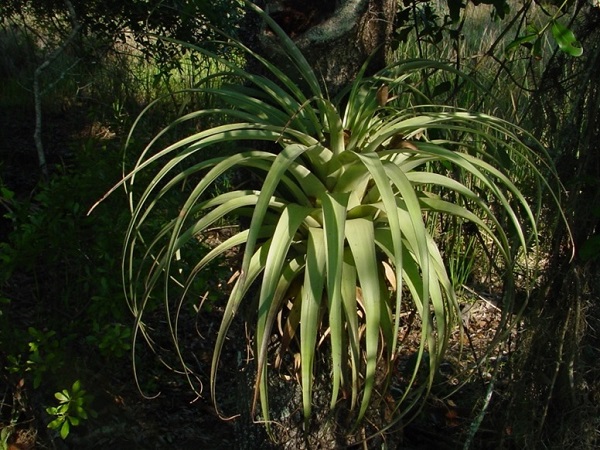
Distribution: Florida, West Indies, Mexico, Central and South America. Distribution in Florida: Before the Mexican bromeliad weevil, commonly found, often in very large, dense populations; now, rare and sparse. Northern boundary runs approximately from Volusia County to Pinellas County to south florida. Habitat: Dry and mesic hammocks, cypress swamps, pinelands. Prefers shady habitats. Description: Tank epiphyte (may grow terrestrially on sandy soil); at maturity, body of plant may be 0.5 m (1.5 ft.) high and 0.7 m (2.3 ft) wide; leaves are light green to grey-grey green, are wide at the base and tamper to the tips; may be 80 cm (31") long. In shady habitat, leaves are hang down around the plant, are wavy and have an appearance of flowing; in sunnier habitat, the leaves are more erect and without the inflorescence present, might be mistaken for T. fasciculata. Inflorescence is tall, green, erect, has a zig-zag configuration and several lateral branches. Flower petals are white and form a tube up to 4 cm (1.6") long. A single plant may form up to 200 flowers and 10,000 seeds. Tillandsia utriculata has a monocarpic habit and senesces and dies after producing seeds. The inflorescence emerges in spring, flowers develop from spring to fall, primarily in the summer and seeds are released in late spring the year after the inflorescence first emerged. Mexican bromeliad weevil: Whe the weevil first arrived, it was obvious that this species was going to be hit hard. Now, after many years of being attacked by the Mexican bromeliad weevil, this species and rare and the large, dense populations are no longer found, and the very largest plants with the tallest inflorescences are rarely seen anymore. Status in Florida: Endangered. Tillandsia variabilis Schltdl.Former names: T. valenzuelana. Common name: Leatherleaf airplant. 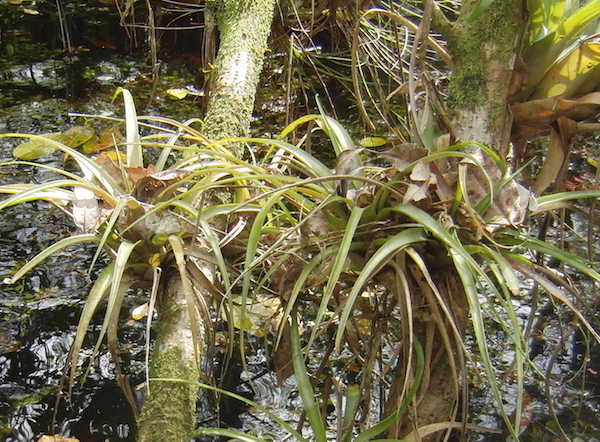
Distribution: Florida, West Indies, Mexico, Central and South America. Distribution in Florida: Occasionally found in southern Florida in the following counties: Broward, Collier, Hendry, Highlands, Martin, Miami-Dade, Monroe, Okeechobee Counties. Occurrence in Florida: Occasional. Habitat: Humid, shady swamp forests and hammocks. Description: Tank epiphyte; plants usually single (not clustered); grows to 30-50 cm (12-20 in.) tall; 15-20 leaves with fine scales, soft, green-gray or silvery (may have rose or purplish coloring), tapering at the top; outer leaves are 2-3 cm (3/4 - 1 1/8 in.) wide at the base; simple flower spike with reddish or purple floral bracts (up to 3.5 cm [1 3/8 in.] long), violet petals (3.5 cm [1 3/8 in.] long), and white sepals (6 mm; ¼ in.). Time of flowering: Spring - fall. Mexican bromeliad weevil: Attacked by the weevil. Status in Florida: Threatened. |